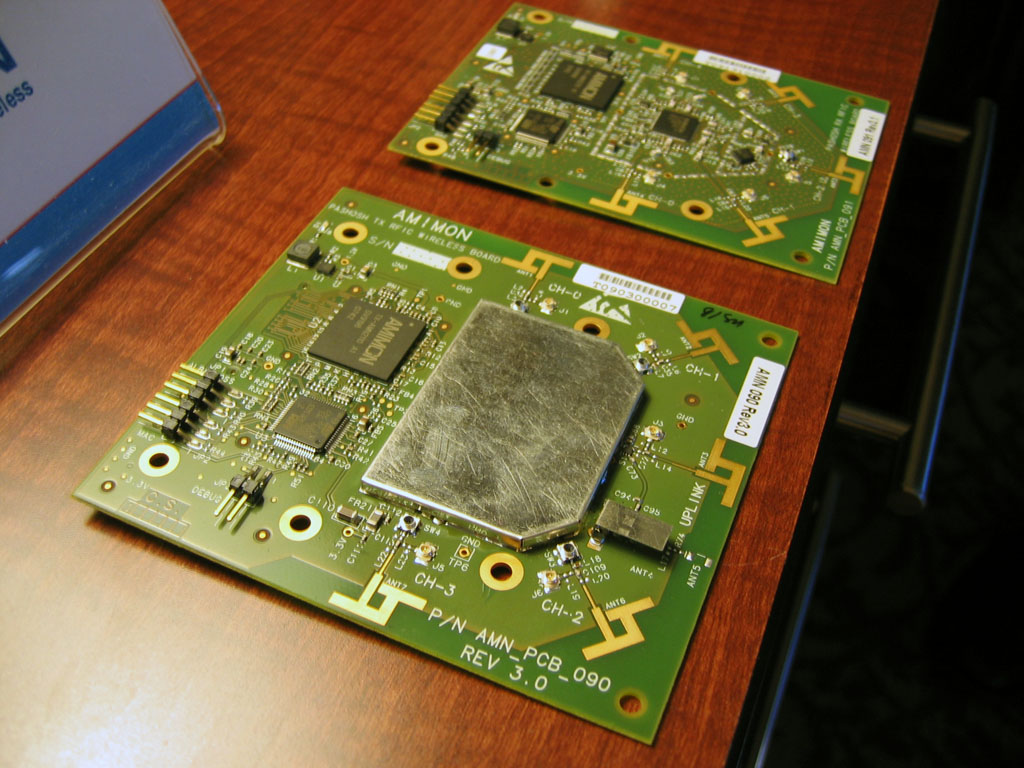CES '09: Morsels From Our Meetings
More Wireless TV And SFF Core i7
The first thing to understand is that Amimon isn’t using a typical data model involving compression (we’ll add lossy to this, since the technology still sounds like a form of lossless compression), transmission, and decompression on the receiving end. Instead, the company classifies its technique as a specialized video mode, which prioritizes the video data (similar to what a compression algorithm might do) and allocates channel resources. All of the data is sent all of the time, according to Amimon, so nothing is ever lost. However, “the most important” information will always be first in line for transmission.
Inevitably, wireless link capacity will dip for fractions of a second, during which time the transmitter continues sending all data and the receiver attempts to receive all data. The result, in fact, is a loss in quality, starting with the data deemed least important by Amimon’s engine. Naturally, the frequency of those dips and the bandwidth available will depend on the distance between the transmitter/receiver and obstacles in the way. But it doesn’t seem like Amimon ever intended for the technology to broadcast content throughout a house. Rather, it’s much better suited to hitting a television on the other side of a room.
We had the chance to test its next generation of wireless technology, which will emerge this quarter, and were unable to correctly guess the TV connected directly and the set operating wirelessly.
A Small Small Form Factor Update
Although we dashed off to eight other meetings/events on the first day, the only other project that really caught our eyes (other than Microsoft’s Windows 7 beta, which we’ll revisit soon), was Shuttle’s display of X58-based small form factor boxes.
Its first wave of Core i7 barebones employs the company’s existing chassis design. The first system will be called the SX58H7, and is reported roomy enough for a pair of AMD or Nvidia cards in CrossFire/SLI. Unfortunately, we weren’t able to peek inside to see if the claim includes dual-slot cards.
Shuttle also had its next-generation design on display and it’s quite sharp. Rather than using flip-down doors to cover externally accessible drives, it employs a small stealth door that swings open.
Get Tom's Hardware's best news and in-depth reviews, straight to your inbox.
We had hoped to write this month’s System Builder Marathon series a little differently, using compact enclosures for each of our price points. But because there weren’t any X58-based micro-ATX motherboards available yet, we had to put that project on hold. Now it’s looking like Shuttle will follow up the i7’s launch, lagging by just a couple of months, with a complete barebones platform that might wind up serving LAN party aficionados well.
Current page: More Wireless TV And SFF Core i7
Prev Page More USB 3.0 And Wireless TV Next Page Intel And Sapphire-
neiroatopelcc So a new socket is planned for mainstream core i7 systems? If that's the case, why even invest in an x58 in the first place?Reply -
squatchman Reading hard!Reply
"Core i7 variant later this year with on-chip graphics, a different socket interface, and two channels of DDR3 memory support. "
It sounds like a crippled version of i7. Dual channel memory that takes DDR3 and some weak IGP? No thank you. -
enewmen At about that time, the socket LGA-1366 and LGA-1567 will be moving to server space while the LGA-1156 is for Desktop platforms. The good news is the Desktop platform when Sandy Bridge is released should be a lot faster for apps like games, recoding, etc. While the server platform will be better for databases, VMs, and other high-IO applications. I don't know yet if Sandy Bridge will be LGA-1156 or 1366, but I guess 1156.Reply
.001 cents worth. Lots of info on the web. -
cangelini squatchmanReading hard!"Core i7 variant later this year with on-chip graphics, a different socket interface, and two channels of DDR3 memory support. "It sounds like a crippled version of i7. Dual channel memory that takes DDR3 and some weak IGP? No thank you.Reply
It's all about getting that architecture into the mainstream though, right. For as well as it performs, i7 is still an expensive proposition. -
JonnyDough Too expensive. Which is why Phenom II seems to be picking up a bit of steam. Intel always seems to have issues with socket changes.Reply -
TwoDigital Reading through multiple web sites (including Intel's 2009 roadmap presentations) the socket 1366 is being targeted at 'enthusiast' users. They are also releasing a socket 1567 server connect (replacing the current Xeon socketj 771) and an entry-level socket 1160.Reply
Rumor has it the 1160 will retain the dual-channel memory controller system. The current i7s are based on LGA 1366 and the high-end motherboards I would expect to stay that way for the foreseeable future.

